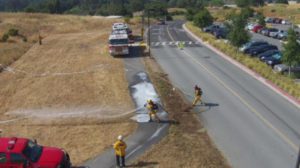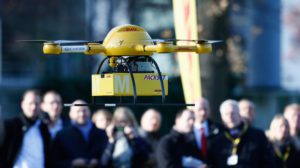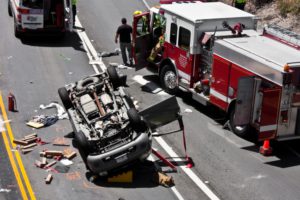Using A LiDAR Equipped Drone & 3D Modeling to Innovate the Engineering and Construction Industries
The process of 3D mapping isn’t new. Most traditional methods use “boots on the ground” surveying or more recently drone photogrammetry. This is the science of making measurements from photos. The result is typically some kind of map, a set of measurements, or even a 3D model of some object or landscape feature. Many of the maps we use daily were created using photogrammetry and images taken from aircraft or satellites.
Mapping with drones is very similar to this, the main differences being the low altitude a drone can fly, and the tighter control one has over the platform itself. These key differences mean a user can capture much more data and higher quality images. But, when you combine a drone with LiDAR technology, the entire process is enhanced tenfold.
LiDAR (Light Detection and Ranging) is a remote sensing technology that uses the pulse from a laser to collect measurements. These measurements are then used to create 3D models and maps of objects and environments.
The concept of drone 3D mapping possesses enormous potential for engineering, construction, agriculture, mining, infrastructure inspection, and real estate. Having a clear, accurate digital database or 3D model of your project area, complete with measurements, is advantageous for many uses.
How Does Drone 3D Mapping Work?
In drone 3D mapping, a LiDAR scanner is taken aloft by a suitable UAV, which is then flown in a predetermined autonomous pattern over the terrain or objects to be mapped. (Sidebar: It’s amazing to think about the current status of autonomous automobiles compared to UAVs. We are already taking autonomous UAV flights daily.) LiDAR mapping uses a laser scanning system with an integrated Inertial Measurement Unit (IMU) and GPS receiver that allows each measurement, or point in the resulting point cloud, to be georeferenced.
Each ‘point’ combines to create a 3D representation of the target object or environment. LiDAR maps can be used to give positional accuracy – both absolute and relative, to allow viewers of the data to know the exact location on the globe from which the data was collected, and how each point relates to other objects in terms of distance.
Data gathered from a LiDAR-equipped drone 3D mapping mission can be used to map entire regions down to the smallest detail, enabling users to accurately pinpoint features, structures, or areas of interest in perfect detail. Features and objects such as waterways, canals, lakes, rivers, road networks, bridges, even rocks and vegetation, can be located and classified with exquisite accuracy.
How Can Engineering & Construction Companies Use Drone 3D Mapping?
The most common task for LiDAR systems is surveying. When combined with the versatility of drones, the benefits over a typical boots-on-the-ground survey are significantly multiplied. Drones can fly where people or other vehicles find it impossible to go, and stay for extended periods of time.
Both the engineering and construction industries rely heavily on accurate survey work. As the project becomes larger, more complex, or more remote, the difficulty in obtaining accurate survey data rises. Drones can safely go where people cannot, stay longer and do more with less equipment, and still provide exceptionally high-quality data.
How the “Water Advisors to the West” Used Drone 3D Mapping
The Applegate Group, known as the “Water Advisors to the West,” provides clients expertise in
water planning, water rights engineering, water policy, and development of water infrastructure. This helps to ensure access to a continuous supply of clean, uncontaminated water for drinking, living, and recreational uses.
The Applegate Group obtained government grants from the Bureau of Reclamation and the Colorado Water Conservation Board which is part of the Colorado Department of Natural Resources. The grants were used to obtain topographic data for use in rehabilitating a 15-mile long canal that will ultimately provide more water for irrigation to farmers in the Fruitland Mesa.
1UP Aerial Drone Services and Drone 3D Mapping
The Applegate Group contracted with 1UP Aerial Drone Services to collect LiDAR data to
develop LAS point clouds of bare earth surface data to estimate cut/fill volumes for a 15-mile-long ditch lining and reshaping configuration project that will serve more water to 5,000 acres near Crawford, CO.
1UP Drones along with HTS Advanced Systems flew a LiDAR equipped drone that is equivalent to the price of a small house ($250,000) over a very dangerous canal. This involved a large amount of flight planning, obtaining access to the canal, overcoming two days of snow and sleet, plus initially convincing the client that 1UP was able to execute the planned task.
This was the first LiDAR drone 3D mapping mission The Applegate Group had ever contracted, so the entire process was new and they maintained a healthy amount of skepticism about the promised results. Moreover, the terrain was extremely treacherous, with wildlife, rock outcroppings, a deep canopy of trees and underbrush all being a concern.
What Were the Results?
In the past, the Applegate Group would have been forced to expend precious dollars, time, and manpower in a dangerous area. Kris Crawford of the Wilmore Land Surveying Company (who we worked very closely with) would have had to transport heavy equipment by 4-wheeler, and their plan was to capture every 100-foot transect leaving engineering extrapolation and guesswork for the canal between the 100 feet. Difficulty with the terrain would likely have prevented Kris from providing as much data for the survey as the UAV ultimately collected.
After viewing the results of the drone 3D mapping mission, Craig Ullman, VP, Applegate Group, said, “The 1UP LiDAR UAV data and precision equals fewer surprises and more accurate canal rehabilitation estimates.”
As a result of the data collected by 1UP through drone 3D mapping, the following crucial costs were controlled for improved construction and ultimately more water:
- Balance of cut/fill quantities
- Minimized shotcrete volume
- Minimized membrane requirements
- The Applegate Group expects to increase the canal water flow by 7 cubic feet per second and provide farmers an extra 2 weeks in the irrigation season
- More data and precision than what could have been accomplished with “boots on the ground” surveying
- 50% less time in data collection
- 25% less cost in data collection
How Can Drone 3D Mapping Help Your Engineering & Construction Projects?
Surveying for site preparation and other operations can be greatly enhanced with drone 3D mapping. Typically, engineering and construction firms don’t have the desire to invest the capital to operate an expensive drone with LiDAR, provide the resources for personnel to acquire the FAA Part 107 certifications, and provide for the insurance, risk, and daily expertise necessary.
Therefore, contracting with 1UP Drones makes for a great partnership with forward-thinking surveyors, engineers, and construction companies. 1UP provides the equipment and expertise for surveying missions, while engineering and construction companies gain highly accurate survey data for a variety of applications, with minimal personal investment compared to maintaining their own drone operations.
For more information about how 1UP Drone Services can provide your engineering or construction business with drone 3D mapping, call us at 720-476-4101 or contact us online.


